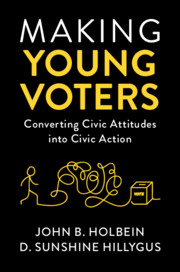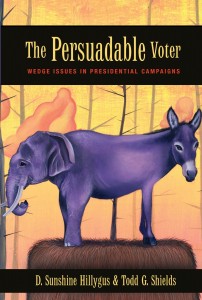 In Making Young Voters, we examine the causes of and solutions for the low levels of youth turnout in the United States. Contrary to popular wisdom young people are not politically apathetic; Rather, they too often fail to follow through on their political interests and intentions. We offer a new theory of voter turnout that helps to explain the gap between intention and behavior. We contend that political scientists have overlooked the role of an important set of malleable non-cognitive skills associated with self-regulation and sociability. Recently, these non-cognitive skills have received a great deal of attention in economics, education, and child development research—with scholars in these fields showing that non-cognitive skills are not rigid across the life course, but are, instead, teachable, and are predictive of school and labor force outcomes. Using a unique combination of longitudinal surveys, large-scale school administrative records, and public voter files paired with experimental, quasi-experimental, observational and qualitative techniques, we provide the first comprehensive evidence that young people who develop non-cognitive skills are much more likely to vote in adulthood than those that do not. We then explore possible solutions rooted in civic education and electoral reform.
In Making Young Voters, we examine the causes of and solutions for the low levels of youth turnout in the United States. Contrary to popular wisdom young people are not politically apathetic; Rather, they too often fail to follow through on their political interests and intentions. We offer a new theory of voter turnout that helps to explain the gap between intention and behavior. We contend that political scientists have overlooked the role of an important set of malleable non-cognitive skills associated with self-regulation and sociability. Recently, these non-cognitive skills have received a great deal of attention in economics, education, and child development research—with scholars in these fields showing that non-cognitive skills are not rigid across the life course, but are, instead, teachable, and are predictive of school and labor force outcomes. Using a unique combination of longitudinal surveys, large-scale school administrative records, and public voter files paired with experimental, quasi-experimental, observational and qualitative techniques, we provide the first comprehensive evidence that young people who develop non-cognitive skills are much more likely to vote in adulthood than those that do not. We then explore possible solutions rooted in civic education and electoral reform.

The use of wedge issues such as abortion, gay marriage, and immigration has become standard political strategy in contemporary presidential campaigns. Why do candidates use such divisive appeals? Who in the electorate is persuaded by these controversial issues? And what are the consequences for American democracy? In this provocative and engaging analysis of presidential campaigns, Sunshine Hillygus and Todd Shields identify the types of citizens responsive to campaign information, the reasons they are responsive, and the tactics candidates use to sway these pivotal voters. The Persuadable Voter shows how emerging information technologies have changed the way candidates communicate, who they target, and what issues they talk about. As Hillygus and Shields explore the complex relationships between candidates, voters, and technology, they reveal potentially troubling results for political equality and democratic governance.
The Persuadable Voter examines recent and historical campaigns using a wealth of data from national surveys, experimental research, campaign advertising, archival work, and interviews with campaign practitioners. With its rigorous multimethod approach and broad theoretical perspective, the book offers a timely and thorough understanding of voter decision making, candidate strategy, and the dynamics of presidential campaigns.
 American democracy relies on an accurate census to fairly allocate political representation and billions of dollars in federal funds. Declining participation in previous censuses and a general waning of civic engagement in society raised the possibility that the 2000 count would miss many Americans–disproportionately ethnic and racial minorities–depriving them of their share of influence in American society and yielding an unfair distribution of federal resources. Faced with this possibility, the Census Bureau launched a massive mobilization campaign to encourage Americans to complete and return their census forms. In The Hard Count, former Census Bureau director Kenneth Prewitt, D. Sunshine Hillygus, Norman Nie, and Heili Pals present a rigorous evaluation of this campaign. Can a busy, mobile, and disengaged public be motivated to participate in this civic activity? Using a rich set of data and drawing on theories of civic mobilization, political persuasion, and media effects, the authors assess the factors that influenced participation in the 2000 census.
American democracy relies on an accurate census to fairly allocate political representation and billions of dollars in federal funds. Declining participation in previous censuses and a general waning of civic engagement in society raised the possibility that the 2000 count would miss many Americans–disproportionately ethnic and racial minorities–depriving them of their share of influence in American society and yielding an unfair distribution of federal resources. Faced with this possibility, the Census Bureau launched a massive mobilization campaign to encourage Americans to complete and return their census forms. In The Hard Count, former Census Bureau director Kenneth Prewitt, D. Sunshine Hillygus, Norman Nie, and Heili Pals present a rigorous evaluation of this campaign. Can a busy, mobile, and disengaged public be motivated to participate in this civic activity? Using a rich set of data and drawing on theories of civic mobilization, political persuasion, and media effects, the authors assess the factors that influenced participation in the 2000 census.
The Hard Count profiles a watershed moment in the history of the American census. As the mobilization campaign was underway, political opposition to the census sprang up, citing privacy concerns and seeking to limit the kind of data the census could collect. Hillygus, Nie, Prewitt, and Pals analyze the competing effects of the mobilization campaign and the privacy controversy on public attitudes and cooperation with the census. Using an internet based survey, the authors tracked a representative sample of Americans over time to gauge changes in census attitudes, privacy concerns, and their eventual decision whether or not to return their census form. The study uniquely captures the public’s exposure to census advertising, community mobilization, and news stories, and was designed so people could view video clips and photos of actual campaign advertisements on their sets in their homes. The authors find that the Census Bureau campaign did in fact raise awareness of the census and census participation. The mobilization campaign was especially effective at increasing participation among groups historically undercounted by the census. They also find that census participation would have been even higher if not for the privacy controversy, which discouraged many people from cooperating with the census and led others to omit information from their census form. The findings ofThe Hard Count have important policy implications for future census counts and offer theoretical insights regarding the influence of mobilizations campaigns on civic participation.
The goal of full and equal cooperation with the decennial census and other government surveys is an important national priority. The Hard Count shows that a mobilization campaign can dramatically increase voluntary participation in the decennial headcount and identifies emerging social and political challenges that may threaten future census counts and contribute to the growing fragility of our national statistical system.
